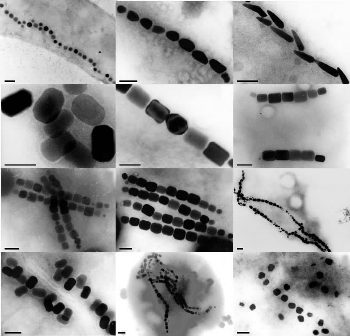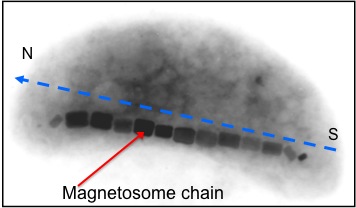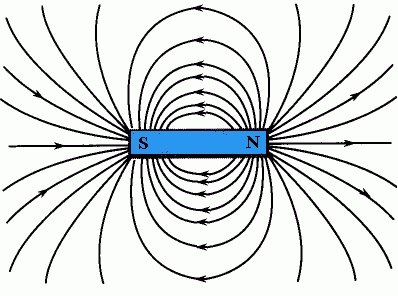INDEX
Introduction to Bioelectromagnetism
Pigeons
Electric Eels
Sharks
Bibliography
Magnetotactic Bacteria
Magnetotactic bacteria orient themselves and move along magnetic field lines. This positioning is possible because of the prescence of magnetosomes, small organelles (distinct structures within a cell) of magnetic iron material wrapped in a membrane. A picture of a magnetotactic bacterium and magnetosomes present in the bacteria are displayed below:
Magnetosomes Magnetotactic Bacterium


http://scienceblogs.com/afarensis/upload/2006/01/magnetosomes_xl.jpg
http://magnetolab.bio.lmu.de/de/bilder/forschung041.jpg
Magnetosomes function as a type of biological compass needle for the bacteria. The chain of these organelles serves as a magnetic dipole (example shown below) and helps the bactria in sensing its orientation. This allows for passive orientation to Earth's geomagnetic field. They each have a flagellum, which helps the bacteria move around.

http://www.antenna-theory.com/definitions/magneticDipole.jpg
Magnetotactic bacteria exhibit two distinct behaviors regarding their magnetic orientation. In polar motion, the bacteria swim North or South. In axial motion, the bacteria oscillate back and forth. One can see both a video of magnetotactic bacteria and magnetotaxis, motion in coordination with a magnetic field.
Magnetotactic Bacteria Magnetotaxis
_____________________________________________________________________________________________________
"Research" Ludwig-Maximilians-University
Munich. Accessed 4/10/2012 from
http://www.uni-muenchen.de/funktionen/kontakt/index.html
Chen,
L., Bazylinski, D. A. & Lower, B. H. (2010).
Bacteria That Synthesize Nano-sized Compasses to
Navigate Using Earth's Geomagnetic Field. Nature
Education
Knowledge 1(10). 14.
"More
on Magnetic Bacteria" Afarensis.
Accessed 4/10/2012 from http://scienceblogs.com/afarensis/2006/01/24/more_on_magnetic_bacteria/